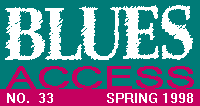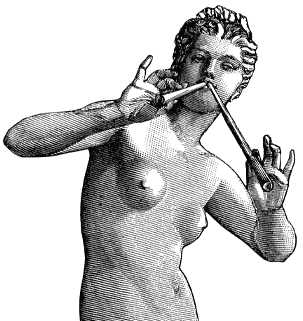

 | ||
| The Doctor is In! |
Apologies all around. The Chez Harpo mailbox has been chock-a-block full of calls of distress for the past few months. So, in all fairness, I triaged the lot of them, giving top priority to those which seemed in the most acute distress or those including cash or checks which cleared by publication time, and published them last issue. The letters below may have been around for a few months, and I apologize for the delay. Now watch, Iíll get a letter from Steven Hawking.
Dear Harpo,

The enclosed is just an idea. What do ya think? (Copy of enclosure reads as follows:)
Blue Dragon Music is a non-profit organization giving music to the world. The instrument of choice, the harmonica. Why the harp? No electricity needed, fits in the pocket, easy-to-learn basics.
Blue Dragon Music: Blue, for the blues that made the harp famous; Dragon, symbol of spirit and breath needed to play the harp; Music, source of inner joy for player and listener.
We will give a harp and basic instruction sheet to anyone who requests or is referred, subject to available supply and waiting list. All donations accepted, used in turnaround for new harps, mailings, etc. Donations are tax deductible. Please help us give music to the world.
Michael J. Cushman
The Master scratches his head but is confident that he has a can of matching touch-up paint for it around here somewhere ...
Dear Mike,
This is a wonderful idea! Youíve probably already contacted the various manufacturers for donations of usable reject and discontinued harps in addition to asking them for donations of harps and dough for this venture. Iíll bet the various harp-by-mail outlets, microphone and amp manufacturers, as well as publishers of instructional materials and record companies, would all pitch in as sponsors, too, especially if you included a list of sponsors and their products with your harp starter packs.
Thereís a lot of great harp players yet to be discovered, and your project could help start them off! Any interested parties now have your name and address, so, get in touch with Mike if youíd like to get in on the ground floor. Good luck!
Dear Harpo,
Iíve been playing using the "lipping" method for almost eight years, when a friend introduced me to "tongue blocking." Woo hoo! And after reading David Barrettís Building Harmonica Technique, Iíve concentrated on incorporating it into my style.
Through practice I can do most things using tongue blocking that I can do lipping (bending, overblowing, blow bending), and overall it has superior tone and versatility (tongue slapping and octaves), but I figure that lipping must have its own inherent advantages too. Where is lipping superior to tongue blocking? I thank you for your glorious pearls of wisdom and enclose $20.
In Transition, Phil
Daylesford, Australia
Dear Transitional Phil,
Thanks for your letter, but the twenty must be coming under separate cover, as it still hasnít arrived yet. I, too, am a recently reformed member of Puckererís Anonymous, that elite corps of harp players who purse their lips demurely to achieve one single note at a time.
I could do most things with this technique but always found my tone to be thinner and reedier than I wanted. Always used tongue blocking for octaves and special percussive effects such as the ones you mentioned, and, like you, found that I got a fuller tone when doing so. So, now I use lipping for times when I want a thinner tone, for contrast, and also for high blow bends, and tongue blocking for everything else.
If you want a really trebly sound, lipping is the thing. Also, I did find that my harps lasted forever with lipping, as you donít goop them up as much. You can hear Jimmy Reed, Sonny Boy II and Little Walter switch to lipping for certain special effects on various recordings; listen for the sudden ultra-trebly tone.
For a nifty discussion and demo of these two techniques in detail, both on diatonic and chromatic, watch Mark Hummelís Harmonica Party video, which also has discussions on techniques of harp masters like those mentioned above and a lengthy discussion of both chromatic blues harp and third position, the most frequently asked-about aspects of harp playing (in this column, anyway). Best instructional video on amped harp that Iíve seen, by far. Phil and all yíall can mail order it from the usual sources of harp arcana which advertise in BLUES ACCESS. Well worth the dough! (And look for a full review of it in next issueís "Blues Clues.")
Dear Harpo,
What about "Whammer Jammer" by the J. Geils Band? Although itís maybe not a blues tune, has there ever been such a high-energy harp recording? If so, please refer me to it, then. This one keeps me wide awake behind the wheel when I start dozing. Also, I canít find much info on Magic Dick, could you help me with some web references?
Bill Campbell
campbill@earthlink.net
Dear Bill,
I read your letter to Dick, and he wasnít sure whether you meant to ask for other high-energy recordings by other artists (he recommends "Back Track" by Little Walter; I suggest " Off the Wall" and "The Creeper" by James Cotton and "Roller Coaster" by Little Walter), or other recordings that Dick has done which will serve to keep you from mowing down pedestrians.
He humbly suggests "Stoop Down #39" from Geilsí Nightmares as an even more energetic harp workout and "Mean Love" from Bloodshot. As to newer releases with Bluestime, Dick recommended "Full Court Press" and "Some Sweet Day"(both done on Magic Harps) and "Jumpiní Blues," all from the first Bluestime CD. Happy motoring!
Another plaintive cry for help, with feedback banshees yet...
Dear Harpo,
While in search of perfect sound, I encountered an advertisement for what seemed to be the ultimate whizbang that would end my long journey. The putative solution, which cost me more than a minor sum, is a CM harmonica pre-amp. It wails with feedback like a banshee. I tell ya, I have tried it in a variety of practice and gig settings through a host of amps and PA boards. My bandmates get an evil look in their eyes if they suspect I am going to try it "just one more time." If you have any tips on using such devices, please tip on.
Jazbo
Never one to overtip ("Is 5 percent too much? Would I make her feel I only want her for her biscuits?"), the Listing Hipster tips over, and tips on in...
Dear Jazbo,
The first problem is that youíre dyslexic. The MC Pre-amp is from MC Electric owner, Mike Clements, who designed this gizmo specifically for plugging directly into a board, not via an amp. Assuming your tone levels are appropriate, feedback when using a pre-amp means too much signal, as it always does, probably originating in too much gain ó that is, too strong a signal arriving at the power amp.
It can be fine for guitarists to wrestle with feedback but itís unmanageable noise to harpists. So try backing down on the amount of distortion, gain and volume on the pre-amp and try going directly into the soundboard. If that doesnít work, noodle around just about at the feedback level with your tone settings and try having your sound man do the same ó to cut the offending frequency without filleting your sound.
And make sure youíre out of the path of the sound coming out of the speakers so it isnít blasting into your mike. Last resort would be to call MC himself at 011 44-1792-3680-80 or write him at 60 Queenís Road, Mumbles, Swansea, UK SA3 48N. Be patient, and get your friends some roadie ear protection, as itíll take some experimentation to solve this most common affliction of harp players.
Wearing an expression that denotes either displeasure at the dyspepsia ensuing from this a.m.ís special of two-for-one Dinty Moore and jelly biscuits at the Ipecac Cafe or else indicates the incipient rumbling of cosmic laughter from deep within the Master Blaster, or maybe some of each, he and his biscuits rise as one to tootle off into a gravy flavored sunset. Donít worry, weíll wake him for mail call.
Send your knotty questions, suggestions and cash donations to the musical jester of indigestion c/o BLUES ACCESS:
 |
 |